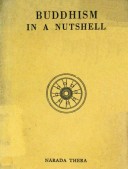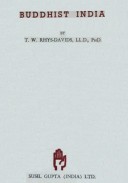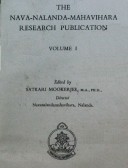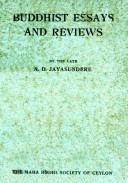Tìm Sách
Sách tiếng Anh-English >> The Way To Peace & Happiness
Thông tin tra cứu
- Tên sách : The Way To Peace & Happiness
- Tác giả : Yogavacara Rahula
- Dịch giả :
- Ngôn ngữ : Anh
- Số trang : 191
- Nhà xuất bản : The Corporate Body of the Buddha Education Foundation
- Năm xuất bản : 1975
- Phân loại : Sách tiếng Anh-English
- MCB : 12100000011622
- OPAC :
- Tóm tắt :
FOREWARD
This book has been put together in order to give the reader a thorough familiarization and understanding of the underlying principles and aspects of the Teachings of the Buddha Gotama. The teachings rendered here are mainly those from the Pali tradition of Buddhism, which are acclaimed to be the direct oral teachings given by the Buddha Gotama in India some two thousand five hundred years ago. These teachings were memorized by his direct disciples and later written down in the Pali language in which the Buddha spoke. Today these teachings are still being widely read, honoured and practiced, especially in the countries of Thailand, Burma and Sri Lanka. And now also they are gaining recognition and popularity in the western countries because of their evident practical significance and application in our daily lives. These teachings are termed the Theravada, the word of the Elders.
Included herein is only a selection of suttas or discourses from the original sermons which the Buddha directly gave or given from memorization by some of his saintly disciples. These discourses were delivered to monks and laymen who gathered together to listen or to individuals who came specifically up to them and asked or to whom they happened to meet on their foot-travels up and down the length and width of India. In the forty-five years of spreading his wonderful, mind-healing wisdom the Blessed One, as the Buddha was called by his devotees, and his Enlightened disciples, brought peace harmony and happiness to innumerable beings, both human and other-, wise.
The teachings that are expounded concern practicality and daily life for the laymen as well as for the monks, those who abandon worldly home life to give their heart and full time for practice. They describe the various elements of existence which constitute the life of living beings, aspects or subjects of contemplation, reflection and meditation, and guidelines for wholesome living.
In the first part of the book the elements which comprise the central and pivotal ideas and fundamentals on which the practice of Buddhism is based, is laid out in detail. In the second part, the actual way of life and how to practice skillfully the ‘Way to Peace and Happiness’, is also detailed out in many ways. An appendix has been added at the end which is a detailed and penetrative study into the workings of the mental processes involved in our sense experiences to reveal the nature of the mind. Also several other useful extracts which shed different light on the subject are included to aid in deepening one’s understanding. And finally an insight meditation exercise is given for those who would like to begin meditating but who do not have access to a suitable teacher. It is only through actually tuning one’s awareness to the present moment of experience that insight and direct knowledge gradually unfolds.
CONTENTS
Introduction
What the Buddha discovered
The Noble Truths:
The five aggregates of dinging
The Second Noble Truth:
Conditioned existence
The meaning of Karma
Rebirth
The Third Noble truth
Ten fetters and Four Stages of Mental Purification
Nibbana
Questions of King Milinda
The Fourth Noble Truth
The Noble Eightfold Path
Right View
The Four Foundations of Mindfulness
Right Concentration
The Five Spiritual Powers
Questions from King Milinda
Sense Desires
Developing the mind
Using the Dhamma wisely
The Noble Eightfold Path in Practice
Appendix:
Meditation
Sensory cognition
What is Ignorance?
Insight Knowledges
Insight Meditation Exercise
Glossary of Pall terms
INTRODUCTION
By Bhikkhu M. Punnaji
Buddhism is what was taught and practiced by the greatest Sage that India ever produced, Siddharta Gotama, the Buddha. Strictly speaking, it was not his teaching but the eternal truth rediscoverd by him. Buddha is not the name of a person but a title meaning Awakened-One.
Some take Buddhism to be a religion, others regard it as a philosophy. If we carefully examine the earliest records we would see that it should best be described as a psychology or even more appropriately, a psychotherapy. It does deal with religious as well as philosophical, social and individual problems, yet it does so by first bringing them into the field of psychology and solves them as psychological problems. Buddhism is also not a kind of mysterious mysticism as some understand it because even mystic states are understood in Buddhist psychology to be just different altered mental states. Nirvana, the ultimate aspiration of Buddhists, is not a mystic state but a state in which the mind is purged and purified of all Egoconceit and all traces of attachment /greed, aversion/hatred, and delusion.
Buddhism offers it’s own critique of religion. In this, religion is not theocentric, centered around the idea of a creator god, but rather sees it as being centered around the interest of man. Religion is not something that has come down from heaven to fulfill a divine purpose, but something that has grown up on earth to satisfy the deepest of human needs. It is not based on divine revelation but on human discovery. It is not dependent on blind faith and worship but on the understanding of experience through the use of human intelligence. It is not based on history or a story which if proved false would tumble down, but stands on the hard rock of direct personal experience. The practice of religion is not based on the idea of punishment and reward but on selflessness and love, nor is it following the commandments of the creator, but basing one’s actions on a feeling of responsibility for oneself and others.
Buddhism does not regard man as a sinner who is incapable of anything better than appealing to the creator for forgiveness. It regards man as capable of rising above all human weaknesses and cultivating a divine mind through his own efforts. One cannot be saved by any external means but he has to save himself through his own efforts and right technique developed by his mind. The Buddha is not a saviour but a guide who teaches the technique of saving oneself after having tested it himself. The destiny of man is not controlled by the whims of a creator, but by the kind of life he leads, his thoughts speech and actions in accordance with the law of cause and effect. One’s state of mind even determines the situation in which he is reborn. The Buddha taught about rebirth but not in the reincarnation or the transmigration of permanent souls. The life after death is only a continuation of the present process of existence. The Buddha realized that our existence does not begin with this human life nor ends with this life in some kind of eternal heaven or hell afterwards, but he beheld that we have been existing since beginningless time in countless number of various existences according to our accumulated karma and will continue to do so until the whole process is understood and gradually brought to a standstill. Buddhism is a gradual path of mental evolution, where man transcends human weaknesses and attains perfection of mind and finally solves the problem of existence, attains Nirvana.
All problems in life boil down to one psychological problem called Dukkha or suffering. Suffering is not just poverty, starvation and sickness and so forth which modem man commonly talks about. It is more related to mental suffering in the form of confusion, anxiety, depression, grief, worry, restlessness and so forth which are mainly psychological states. Normally these states of mind are considered to be the fault of circumstances. This is why these are seen commonly as economic or social problems. Yet the Buddha points out that they are caused by our mental attitudes and reactions to circumstances, not by the objects or situations themselves. If we really check up inside our mind we will find this is true.
This suffering is understood in Buddhism to be the clash between ourselves and the world around us. To put it in other words, it is the clash between our desires and reality. This means that suffering is caused by unrealistic desires. Reality frustrates these desires in most cases so we wish that reality were otherwise. Our desires are insatiable. The real cause of our suffering is the unrealistic desire, not the reality that frustrates it. The real cause of the economic problem is not the absence of means to satisfy our endless wants, but the presence of these insatiable wants. So the solution of our problems in life is the eradiction of these unrealistic desires which clash with reality and frustrate us and cause us unhappiness. In other words, we have to awaken from our world of dreams and come down to reality, to face and accept reality as it is. This is why Buddhism is not an other-worldly religion or a kind of escapist asceticism but a this-worldly and down to earth realism. Nirvana is not an escape into a trance state of mystical bliss, but rather perfect sanity which goes beyond the so called normality that is itself insanity, from a Buddhist point of view.
To understand Buddhism we have to understand ourselves, as it is merely a description of ourselves. What has to be done is not to examine the pages of old worn out texts, though this may be useful at the outset to find out where we have to go; nor do we have to make long excursions into outer space or make complicated mathematical calculations. The Buddha’s Teachings are like routes on a map which helps us to journey through the labyrinths of our own mind. When the mind is understood we have understood everything. The Buddha said, ‘The world, the beginning of the world, the end of the world, and the path leading to the end of the world is right here in this fathom-long body with its perceptions and consciousness.”
The person who understands in this way need not worry about the problem of an after life. Buddhism is not a worry about circumstances here or hereafter, but a concern about mental states here and now. If we look after the present state of mind, the future will look after itself. Nirvana is a state of being in which the mind is purified of all clinging craving, aversions, ego-conceit and ignorance here and how, not a trance or life after death. If Buddhism is understood and practiced by mankind, this earth would become a place of harmony and happiness; happiness not through plenty and power, but happiness through wantlessness and wisdom.
 Facebook
Facebook
 Google
Google
 Google+
Google+


















